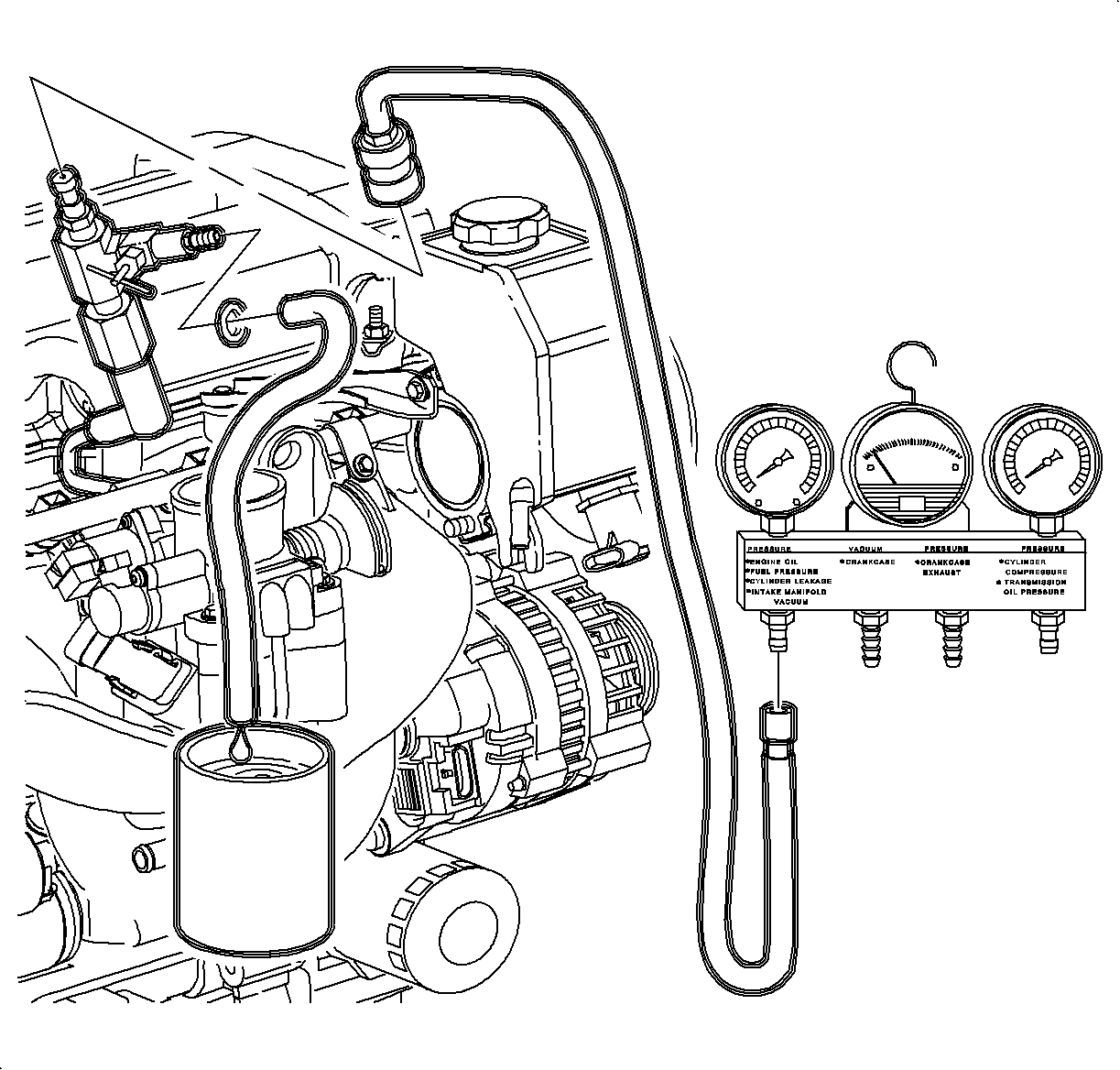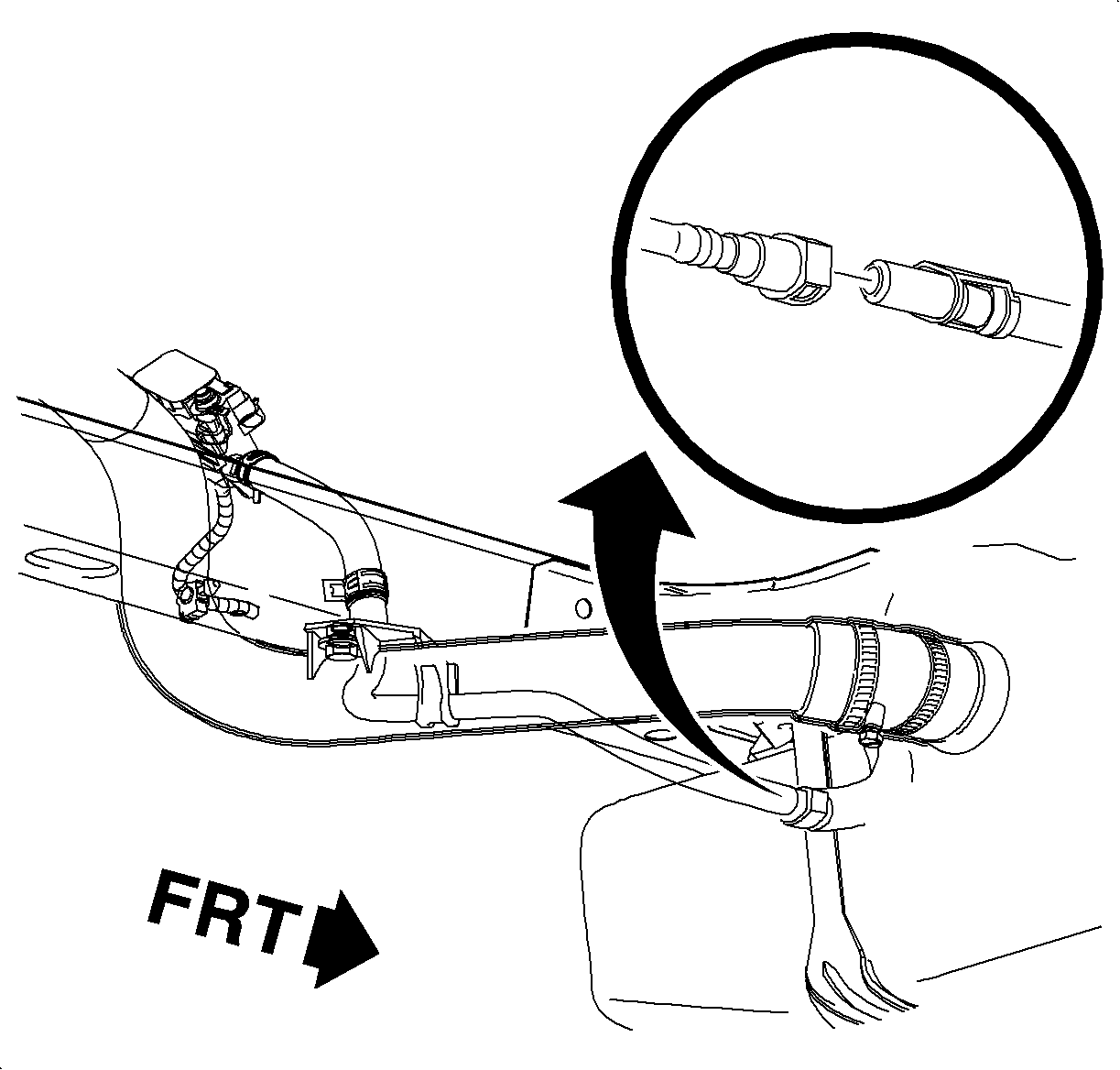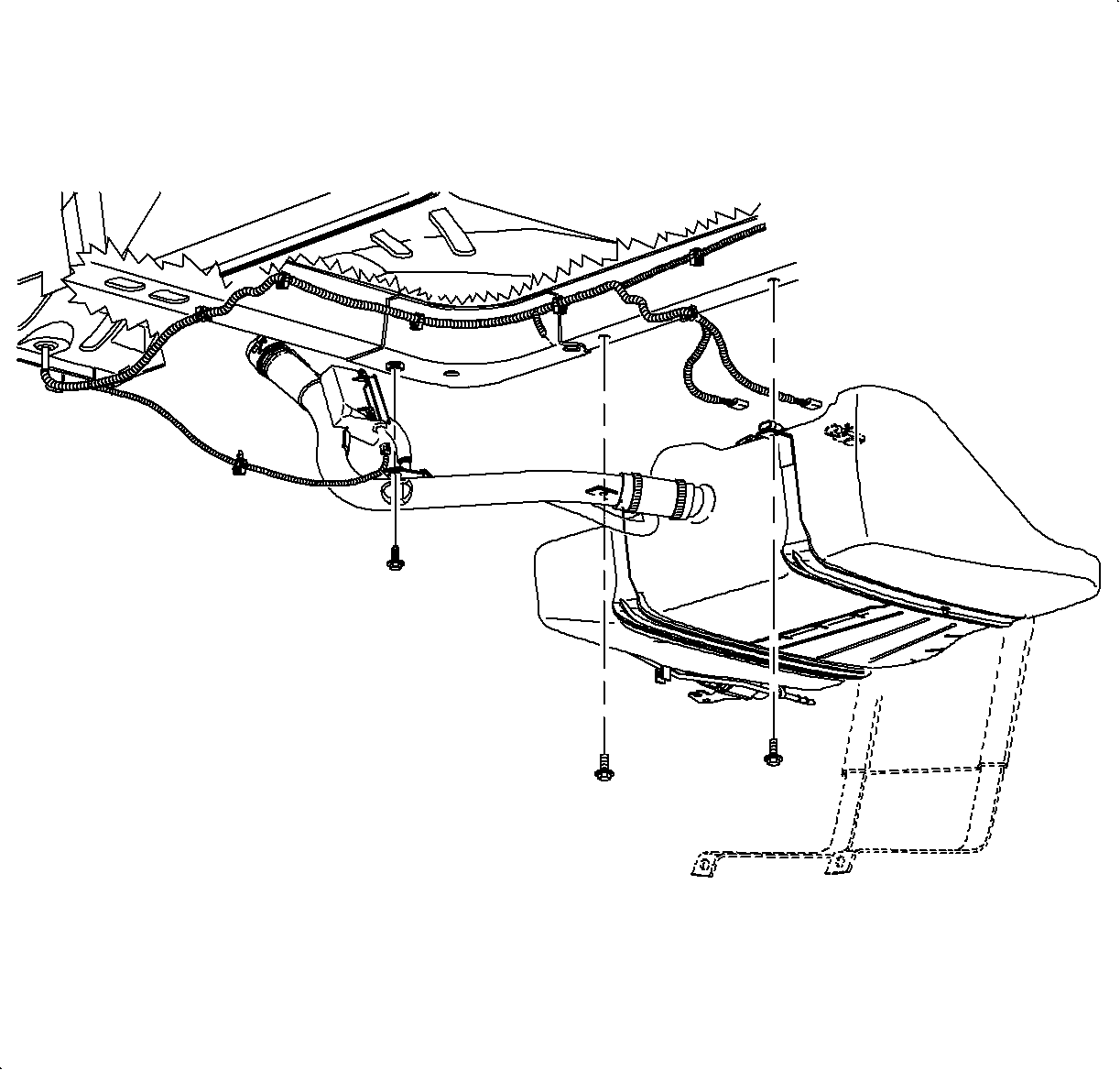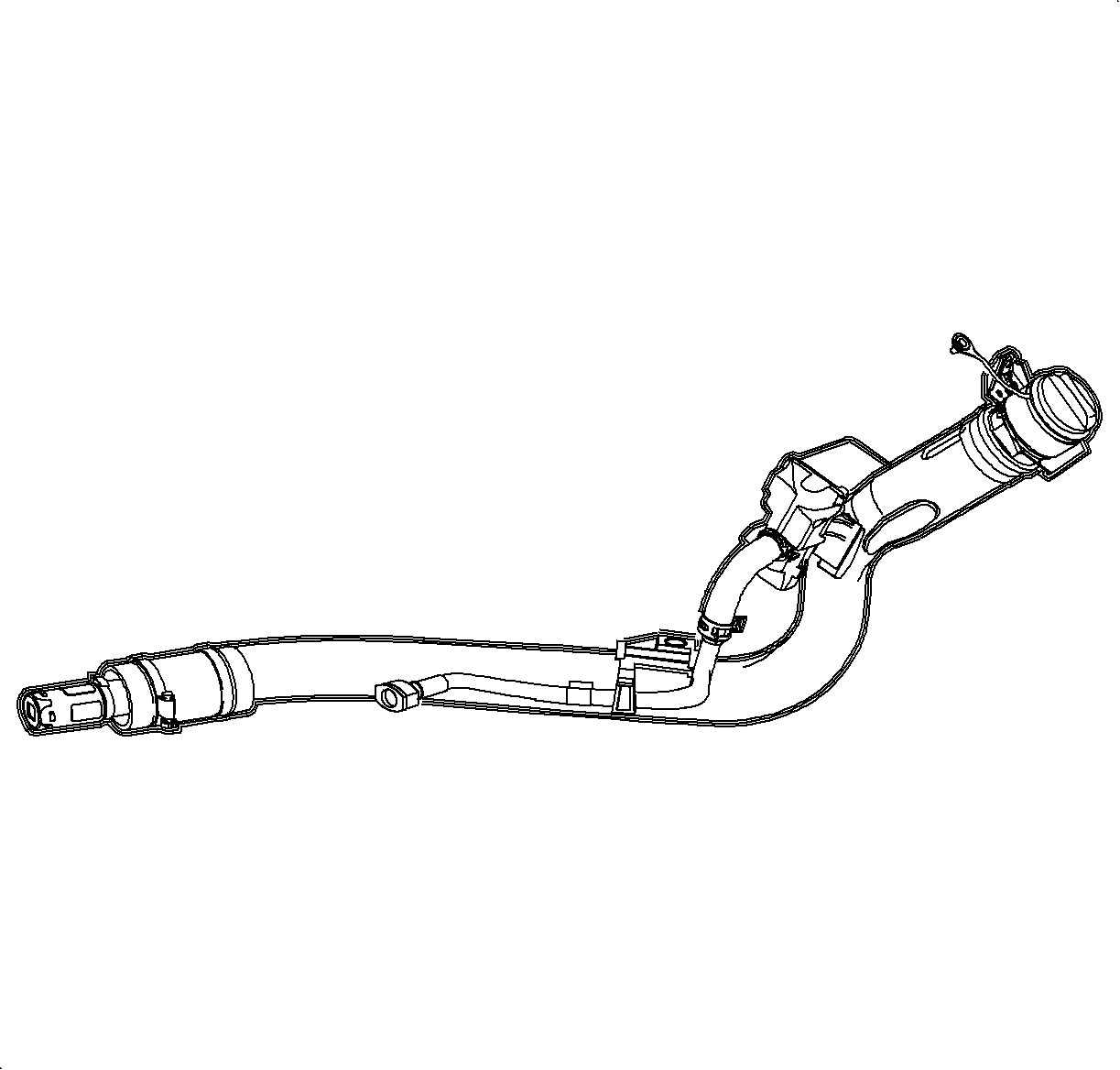Removal Procedure
- Assure that the fuel level in the tank is not greater than half. If necessary, drain the fuel tank to at least this level. Refer to Fuel Tank Draining .
- Position on a hoist.
- Disconnect the negative battery cable.
- Relieve the pressure in the fuel system at the fuel pressure test port. Refer to Fuel Pressure Relief .
- Remove the fuel filler cap and rubber closeout grommet around the fuel filler pipe neck, inside the fuel filler door.
- Remove the attachment screw, T-30, at the upper end of the filler pipe.
- Raise the vehicle to a comfortable working position.
- Remove the wheel house inner liner.
- Disconnect the wiring harness connector from the evaporative emission (EVAP) canister vent solenoid.
- Remove the fuel filler pipe lower bracket attachment screw (10 mm hex) at the underbody left hand side rail.
- Disconnect the EVAP canister vent pipe at the 5/8 in. quick connect to the canister vent hose.
- Loosen the fuel filler pipe hose clamp (7 mm hex) closest to the fuel tank.
- Disengage the filler pipe hose from the fuel tank and remove the fuel filler pipe.
- Remove the 2 screws, 10 mm hex, that attach the fuel filter/pressure regulator bracket to the vehicle underbody.
- Disconnect the fuel feed line, 90 degree quick-connect, from the outlet of the filter/pressure regulator.
- Disconnect the fuel vapor/canister purge line at the 90° quick-connect adjacent to the fuel filter/pressure regulator.
- Slide the filter/regulator bracket out from under the brake lines.
- With the aid of an assistant, remove the 2 tank retaining strap bolts, 15 mm hex, and lower the tank enough to disconnect the 2 electrical connectors to the fuel pump and tank pressure sensor.
- Remove the fuel tank from the vehicle.

Caution: Fuel supply lines will remain pressurized for long periods of time after the engine is shutdown. This pressure must be relieved before servicing the fuel system.


Caution: Several ounces of gasoline may remain in the fuel filler pipe due to the design of the inlet check valve. Be aware of this when handling the filler pipe during removal from the fuel tank. Surround the check valve body with a shop cloth held in place with your hand. Have a suitable container available and drain any fuel by unseating the check valve.
Important: To provide space to remove the filler pipe, guide the top of the filler pipe into the quarter panel opening while removing the fuel filler pipe.

Notice: Keep fuel filler pipe as straight and level as possible when removing it from the tank. Fuel fill check valve clamp may drag on the inlet neck of the tank and care should be used in removing it. If valve is dislodged from filler pipe it may remain in the tank.
Important: If there is more than 11.5 L (3 gal) of fuel in the tank, insert a suitable siphon hose into tank filler neck and remove remaining fuel into a certified fuel handling cart.
Caution: Whenever fuel line fittings are loosened or removed, wrap a shop cloth around the fitting and have an approved container available to collect any fuel.

Installation Procedure
- With the aid of an assistant, position the fuel tank under the vehicle.
- Attach the electrical connectors to the fuel pump and tank pressure sensor.
- Reposition the fuel tank mounting straps and shield around the tank and install the strap mounting bolts, 15 mm hex, to the underbody.
- Install (2) mounting screws (10 mm hex) for the fuel filter/pressure regulator bracket.
- Install a new retainer into the female portion of the 90 degree quick-connect fitting on the underbody fuel feed line.
- Install the underbody fuel feed line onto the outlet of filter/regulator.
- Ensure that the fuel filler check valve is in place at the end of fuel filler pipe.
- Position the filler pipe into the wheel opening with the top of the pipe within the body panel opening.
- Install the fuel filler pipe into the fuel tank opening.
- Loosely install the filler pipe lower bracket attachment screw, 10 mm hex, but do not tighten.
- Lower the vehicle and install the filler pipe upper bracket attachment screw (T-30).
- Install the rubber closeout grommet to the body and filler pipe.
- Install the fuel cap.
- Raise the vehicle to a comfortable working height.
- Tighten the hose clamp, 7 mm hex, on the filler pipe to the fuel tank connecting hose.
- Connect the EVAP canister vent pipe at the quick connect to canister vent hose.
- Tighten the lower attachment screw on the filler pipe to the underbody.
- Connect the wiring harness to the EVAP vent solenoid.
- Install the wheelhouse inner liner to the wheel opening.
- Add fuel, install the filler cap, and connect the negative battery cable.
- Prime the fuel system using either of the following methods:
- Examine the fuel supply line for leaks at the filter/pressure regulator.
- Crank the engine until it starts, allowing a maximum of 15 seconds of cranking time.
- Perform the Service Bay Diagnostic Test for the evaporative emission system using the scan tool. This test will verify the integrity of the vapor handling areas of the fuel system. Refer to Service Stall System (SSS) user guide.

Notice: Refer to Fastener Notice in the Preface section.

Important: Position the fuel tank solidly against the left hand underbody side rail prior to tightening the strap mounting bolts. A small white locator button on the left side of the fuel tank shell should be tight against the left side rail at the completion of installation.
Tighten
Tighten the fuel tank straps-to-body bolts to 47 N·m (35 lb ft).
Tighten
Tighten the fuel filter/pressure regulator-to-frame rail to 8 N·m
(71 lb in).
Notice: Replace plastic fuel line retainers whenever the fuel supply or return line is disconnected at the fuel rail. Install the new retainer into the female cavity of the connection. Care must be taken to ensure that the locking tab is centered in the window of the female cavity. Firmly press the female connection onto the male end until a click is heard, then pull back to confirm engagement. Pinched, kinked, or damaged fuel lines must be replaced.
Important: Lubricate the male ends of the filter/regulator with clean engine oil to ease installation.

Important: To ease installation, lightly wipe the outside of the fuel tank inlet connector with plain water.

Important: Ensure that the EVAP vent solenoid pipe is installed in position on the filler pipe bracket.
Tighten
Tighten the fuel tank fill pipe-to-upper bracket screw to 3.5-4.5 N·m
(31-39 lb in).

Important: Ensure that the fuel pipe connecting hose is installed to within 6 mm (1/4 in) of the stops on the fuel tank inlet connector. The hose clamp should be located within 4 mm (3/16 in) of the end of the connecting hose.
Tighten
Tighten the fuel tank fill hose-to-clamp to 3.5-4.5 N·m (31-39 lb in).
Tighten
Tighten the fuel tank fill pipe-to-underbody rail to 8 N·m (71 lb in).
Tighten
Tighten the battery terminal bolts to 17 N·m (13 lb ft).
| • | Using the ignition, cycle the switch ON for 5 seconds and then OFF for 10 seconds. Repeat this twice. |
| • | Energize the fuel pump using the scan tool. Refer to Fuel System Diagnosis . Run the pump for 10-20 seconds. |
